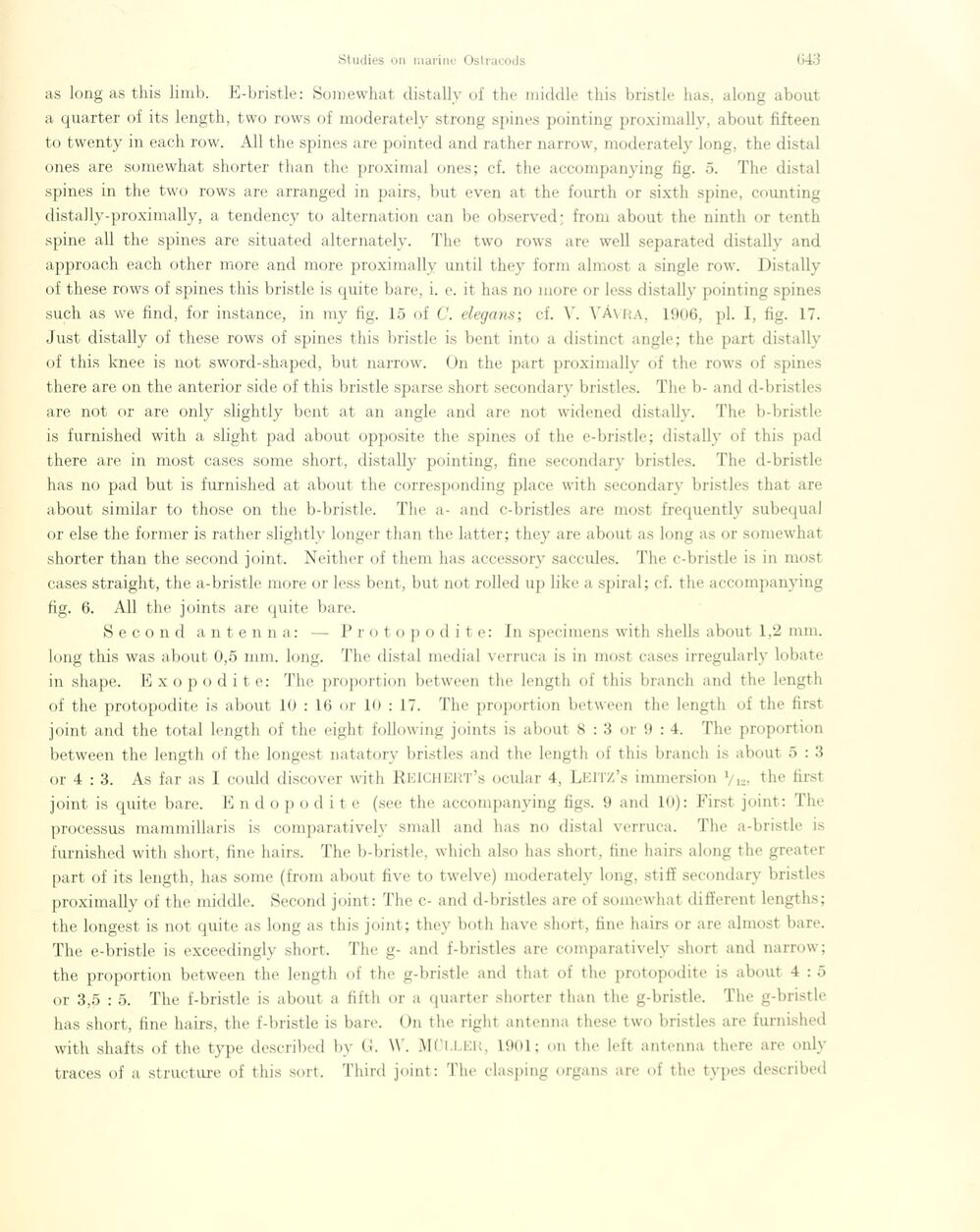
Full resolution (JPEG) - On this page / på denna sida - Sidor ...

<< prev. page << föreg. sida << >> nästa sida >> next page >>
Below is the raw OCR text
from the above scanned image.
Do you see an error? Proofread the page now!
Här nedan syns maskintolkade texten från faksimilbilden ovan.
Ser du något fel? Korrekturläs sidan nu!
This page has never been proofread. / Denna sida har aldrig korrekturlästs.
as long as this limb. E-bristle: Somewhat distali y of the middle this bristle has, along about
a quarter of its length, two rows of moderately strong spines pointing proximally, about fifteen
to twenty in each row. All the spines are pointed and rather narrow, moderately long, the distal
unes are somewhat shorter than the proximal ones; cf. the accompanying fig. 5. The distal
spines in the two rows are arranged in pairs, but even at the fourth or sixth spine, counting
distally-proximally, a tendency to alternation oan be observed; from about the ninth or tenth
spine all the spines are situated alternately. The two rows are well separated distally and
approach each other more and more proximally until they form almost a single row. Distally
of these rows of spines this bristle is quite bare, i. e. it has no more or less distally pointing spines
such as \ve find, for instance, in my fig. 15 of C. elegans-, cf. V. Yäyra, 1906, pi. I, fig. 17.
Just distally of these rows of spines this bristle is bent into a tiistinet angle; the part distally
of this knee is not sword-shaped, but narrow. On the part proximally of the rows of spines
there are on the anterior side of this bristle sparse short secondary bristles. The b- and d-bristles
are not or are only slightly bent at an angle and are not widened distally. The b-bristle
is furnished with a slight pad about opposite the spines of the e-bristle; distally of this pad
there are in most cases some short, distally pointing, fine secondary bristles. The d-bristle
has no pad but is furnished at about the corresponding place with secondary bristles that are
about similar to those on the b-bristle. The a- and c-bristles are most frequently subequal
or else the former is rather slightly longer than the latter; they are about as long as or somewhat
shorter than the second joint. Neither of them has accessory saccules. The c-bristle is in most
cases straight, the a-bristle more or less bent, but not rolied up like a spiral; cf. the accompanying
fig. 6. All the joints are quite bare.
Second antenna: — Protopodite: In specimens with shells about 1,2 mm.
long this was about 0,5 mm. long. The distal médial verruca is in most cases irregularly lobate
in shape. Exopodite: The proportion between the length of this branch and the length
of the protopodite is about 10 : 16 or 10 : 17. The proportion between the length of the first
joint and the total length of the eight following joints is about 8 : 3 or 9 : 4. The proportion
between the length of the longest natatory bristles and the length of this branch is about 5 : 3
or 4:3. As far as 1 could discover with Reichert’s ocular 4, LEITZ’s immersion Vi– the first
joint is quite bare. E n d o p o d i t e (see the accompanying figs. 9 and 10): First joint: The
processus mammillaris is comparatively small and has no distal verruca. The a-bristle is
furnished with short, fine hairs. The b-bristle, which also has short, fine hairs along the greater
part of its length, has some (from about five to twelve) moderately long, stift secondary bristles
proximally of the middle. Second joint: The c- and d-bristles are of somewhat different lengths;
the longest is not quite as long as this joint; they both have short, fine hairs or are almost bare.
The e-bristle is exceedingly short. The g- and f-bristles are comparatively short and narrow;
the proportion between the length of the g-bristle and that of the protopodite is about 4 : 5
or 3,5 : 5. The f-bristle is about a fifth or a quarter shorter than the g-bristle. The g-bristle
has short, fine hairs, the f-bristle is bare. On the right antenna these two bristles are furnished
with shafts of the type described by G. \Y. Mf’LLER, 1901; on the left antenna there are only
traces of a structure of this sort. Third joint: The clasping organs are of the types described
<< prev. page << föreg. sida << >> nästa sida >> next page >>